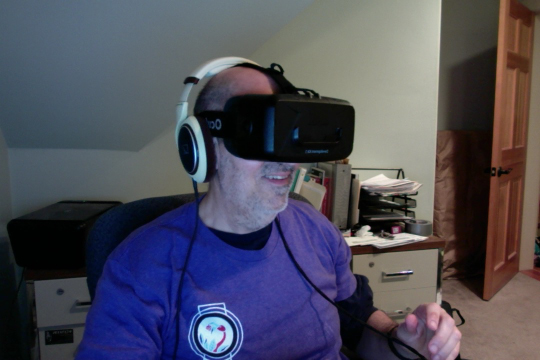Today, we are witnesses to the burgeoning consumer virtual reality, an exciting technology that promises to transform in a fundamental way how we interact with information, our friends, and the world at large.
What is virtual reality? In general, VR is the computer-generated simulation of a 3D environment, which seems very real to the person experiencing it, using special electronic equipment. The objective is to achieve a strong sense of being present in the virtual environment.
Today's consumer tech VR involves wearing an HMD (head-mounted display goggles) to view stereoscopic 3D scenes. You can look around by moving your head, and walk around by using hand controls or motion sensors. You are engaged in a fully immersive experience. It's as if you're really there in some other virtual world. The following image shows me, the author, experiencing an Oculus Rift Development Kit 2 (DK2) in 2015:

Virtual reality is not new. It's been here for decades, albeit hidden away in academic research labs and high-end industrial and military facilities. It was big, clunky, and expensive. Ivan Sutherland invented the first HMD in 1965 (see https://amturing.acm.org/photo/sutherland_3467412.cfm). It was tethered to the ceiling! In the past, several failed attempts have been made to bring consumer-level virtual reality products to the market.
In 2012, Palmer Luckey, the founder of Oculus VR LLC, gave a demonstration of a makeshift head-mounted VR display to John Carmack, the famed developer of the Doom, Wolfenstein 3D, and Quake classic video games. Together, they ran a successful Kickstarter campaign and released a developer kit called Oculus Rift Development Kit 1 (DK1) to an enthusiastic community. This caught the attention of investors as well as Mark Zuckerberg, and in March 2014, Facebook bought the company for $2 billion. With no product, no customers, and infinite promise, the money and attention that it attracted helped fuel a new category of consumer products.
Concurrently, others also working on their own products which were soon introduced to the market, including Steam's HTC VIVE, Google Daydream, Sony PlayStation VR, Samsung Gear VR, Microsoft's immersive Mixed Reality, and more. New innovations and devices that enhance the VR experience continue to be introduced.
Most of the basic research has already been done and the technology is now affordable thanks in large part to the mass adoption of devices that work on mobile technology. There is a huge community of developers with experience in building 3D games and mobile apps. Creative content producers are joining in and the media is talking it up. At last, virtual reality is real!
Say what? Virtual reality is real? Ha! If it's virtual, how can it be... Oh, never mind.
Eventually, we will get past the focus on the emerging hardware devices and recognize that content is king. The current generation of 3D development software (commercial, free, and open source) that has spawned a plethora of indie, or independent, game developers can also be used to build non-game VR applications.
Though VR finds most of its enthusiasts in the gaming community, the potential applications reach well beyond that. Any business that presently uses 3D modeling and computer graphics will be more effective if it uses VR technology. The sense of immersive presence that is afforded by VR can enhance all common online experiences today, which includes engineering, social networking, shopping, marketing, entertainment, and business development. In the near future, viewing 3D websites with a VR headset may be as common as visiting ordinary flat websites today.


























































